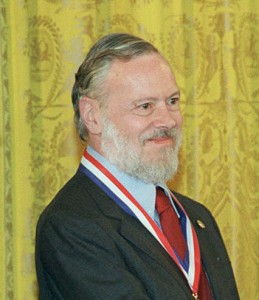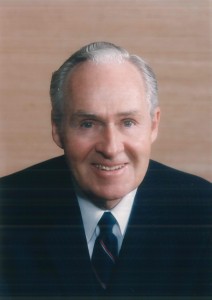Standing on the shoulders of giants
Posted on | October 14, 2011 | 1 Comment
I’ve always appreciated the tag line of Google Scholar: “Stand on the shoulders of giants”. Google itself is a giant in its own right. Yet the tagline helps remind us that the real giants behind the technological successes we all enjoy today are the original researchers whose discoveries and inventions have paved the way for Google and others to achieve their current heights.
October 2011 has become an unprecedented month for the tech industry. Within the space of a week or so it has lost some of its most significant giants. These events have not gone by unnoticed. Many users who turned to Twitter when they heard about Steve Jobs’ passing got the “Fail Whale” instead of tweet streams. The enormous attention his death has attracted is not at all surprising. Steve Jobs was indeed a giant who had a profound impact on all of us, whether you use Apple products or not. It’s important to realize that Job’s impact transcends the current generation of iPhones and iPads. He has taught us perhaps more than any one else, what constitutes a truly excellent technology product. By raising the bar in this way, he has done everybody a favor – his fans, his competitors, and even those of you still living on the dark side with your Windows computers. 😉
However, the tech industry has also lost a couple of other notable giants in recent days that have garnered far less attention. Nevertheless, these individuals have also made enormous contributions and are responsible in part for creating the stage onto which Steve Jobs climbed many years later.
For us computer science junkies, Dennis Ritchie was the “R” in the classic “K & R” C book that many of us learned to program from. He not only was the creator of the C programming language but also made significant contributions to the development of the UNIX operating system. C and UNIX became more and more influential over time. Adoption of these technologies began in the academic setting as AT&T gave UNIX away to universities. It is interesting to note that some years later, Apple computers also followed a similar path to success with an early focus on the education market. Today, almost every computer and smartphone embodies UNIX/C and/or the successors inspired by UNIX/C. For example, your iPhone is running Apple’s UNIX-based operating system, and the apps you have installed have been written in Objective C – a language based on C that was extended with object-oriented syntax. The 190 million Android smartphones Larry Page mentioned yesterday are all running Linux – an open source implementation of a UNIX-like operating system. The Linux kernel is written in C as are many of the lower level libraries and framework. Though Android apps are written in the popular Java programming language, Java’s C pedigree is also evident to programmers familiar with both languages.
Another tech industry giant who passed quietly from the scene this week is Bob Galvin, the man who led Motorola from being a car radio manufacturer to the wireless communication giant that played a large part in creating the modern mobile industry. Bob Galvin, the son of the original Motorola founder, Paul Galvin was every bit the quality obsessed visionary that Steve Job was in his own day. Galvin actually retired before my time at Motorola, though he was still active in the company when I first started in the early 1990’s. I recall actually meeting him on one occasion. Shortly after I joined the company my supervisor (Allan Willey) took me along with him to a meeting involving our CEO (Gary Tooker at the time). In the course of the meeting I noticed a person who I thought was unusually old sitting off to the side and looking rather bored. During a coffee break I casually asked Allan who the “old man” in the corner was and I remember him furiously whispering back “Shhh, that old man is Bob Galvin – chairman of the Board!” Though I did not initially recognize who Bob was when I saw him, I had been around Motorola long enough by then to realize that Bob Galvin was “the man” and held in extremely high regard by everyone. I heard many stories from my older colleagues about Bob which clearly indicated he was a man with great character and vision. He cared not just about the bottom line, but also the people who worked for him. Later when his son Chris became our CEO I felt some of those traits were passed down to the younger generation as well. Though I had very limited interaction with Chris, I do remember him coming by each year to our annual innovation fairs and spending a significant amount of time with those of us in research, taking in our technology prototypes, and interacting with us on a technical level. From my perspective he clearly understood the business, the technology, and really appreciated the technical people who it happen. In any case, without the early pioneering leadership of visionaries like Bob Galvin, there would not be a mobile industry today.
So what can we learn from these recent events? Obviously, the passing of others reminds us of our own mortality in a personal way. The death of anyone, famous or unknown should always give us pause and encourage us to spend time thinking about the deeper issues in life and death, why are we here, how much time do we have left, and what ought our priorities be? Time is a precious resource, and ought to be used as such (I hope my CS students have made it this far in my post…).
Another thing these particular events should remind us of is that behind every high profile success, there are likely a number of prerequisite contributions made earlier by other lesser known but no less important individuals. When possible, in the CS courses I teach I try to help my students develop a historical perspective on the subject we are studying. Every technology has its pedigree and I have observed that the student will appreciate and learn it more readily if they understand something of the minds and circumstances that gave it shape. For example, in the undergraduate systems programming course I teach, in my intro lecture I have a view graph on Dennis Ritchie, Ada Lovelace and others who historically have played an important role in programming as we know and practice it today.
Finally, these events should remind us to thank God daily for giving us a sufficient supply of amazingly gifted people like Steve Jobs, Dennis Ritchie, and Bob Galvin, so that the rest of us have the shoulders we need to stand on!
Comments
One Response to “Standing on the shoulders of giants”
Leave a Reply



January 7th, 2012 @ 11:41 am
I hadn’t heard about Bob Galvin’s passing. It deserved more notice. Keep writing, Jon. I enjoy your blogs and tweets.